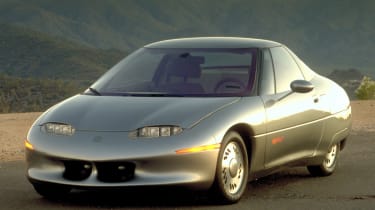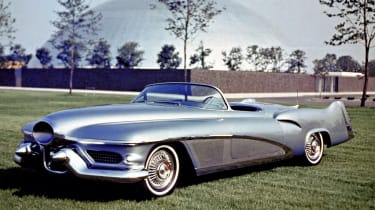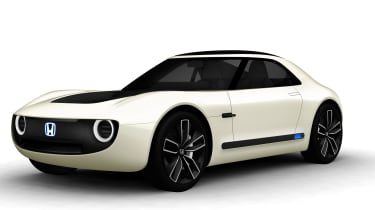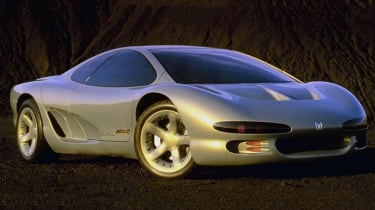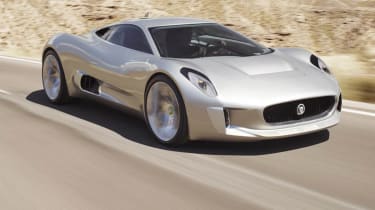Concept cars: the all-time greatest designs
Concept cars are what happens when the car industry lets its imagination run wild. We pick out the greatest ever concepts...
GM Hy-wire (2002)
In the early 2000s, hydrogen power was being touted as the next big step in automotive propulsion. A fuel source that’s plentiful, reasonably cheap and produces efficient power was a tempting prospect, spawning a handful of hydrogen-powered cars such as the Honda FCX Clarity and Toyota Mirai.
The GM Hy-Wire belonged to this strain of automobiles and, whilst it never made production, it was forward-thinking for its time. It was built on a “skateboard” platform (like many of today’s purpose-designed electric cars) which was planned to underpin a range of vehicles, including a family saloon and a two-seater sports car.
The hydrogen fuel cell could supply anywhere between 94kW and 129kW of power. Also all the controls were drive-by-wire. One large electric motor powered the front two wheels, controlled by an electric-throttle. A series of smaller electric motors allowed the steering and brake callipers to be used, their electronic connections taking the place of traditional mechanical and hydraulic controls, and this is another development we’re seeing more and more often in production cars today.
GM Impact (1990)
Electric cars are about to have their day in the sun but manufacturers have been testing the water with battery-propelled vehicles for almost as long as the motorcar has existed. One EV concept that will surely go down as a landmark car in the development of EV technology is the GM Impact shown at the 1990 LA Motor Show.
The Impact would eventually spawn the EV1 electric production car in 1996, GM’s first electric car and a model so advanced that its demise sparked conspiracy theories about forces behind the scenes working to hold back the electric car. The Impact was a coupe with composite bodywork and a slippery drag coefficient of 0.19. It had regenerative braking, a range of 120 miles and three-phase electric motors driving the front wheels that removed the need for a differential or gearbox.
Over 1,100 units of the closely related EV1 were built before it was axed in 2002. The cars featured electric power steering, keyless entry, a pressure warning system for the low rolling-resistance tyres and magnesium alloy wheels. When GM informed customers, who had all leased the cars, that their vehicles were being permanently recalled, there was outcry. Some were deactivated and found their way to museums but the majority were crushed.
GM LeSabre (1951)
Trailing in the wake of the jet-powered revolution in 1950s aviation, automotive manufacturers produced a wave of ‘jet age’-inspired concepts, such as the Fiat Turbina and this, the General Motors LeSabre.
Even though it was powered by an largely conventional 3.5-litre V8, its styling was influenced heavily by jet-powered aircraft, setting the trend for 1950s car design. Its large central intake was reminiscent of the American-made 1946 FJ-1 Fury fighter jet, while its wrap-around windshield and large rear fins would eventually feature on the Cadillac Eldorado and Chevrolet Bel Air.
The engine could run on either petrol or methanol, and the gearbox was mounted on the rear axle.
Honda Sports EV Concept (2018)
Like the Urban EV beneath, the Sports EV Concept is another nostalgic design exercise based on Honda’s back catalogue. The Sports EV Concept borrows styling cues from the famous Honda S600, and blends them with modern technology.
It uses the same platform as the Urban EV, borrowing its technology. However, as the Sports EV was marketed as a sports car, we suspect the drivetrain was reconfigured, with drive being sent to the rear of the car rather than the front.
The dot-matrix display from the Urban EV remained, but is moved to the rear of the car, whilst the rear-view cameras stayed in the same configuration. Fewer details were revealed about the Sport EV’s interior, but it seems to feature the same infotainment system, and the bench seat from the Urban EV was ditched in favour of two sports seats.
Honda Urban EV Concept (2018)
Styled to look like a modern interpretation of the original 1972 Honda Civic, the Urban EV is an all-electric, retro-styled three-door hatchback. Much like its grandfather, Honda’s EV Concept is designed to be a vehicle for short-distance journeys, such as commuting.
Performance figures were never announced, with the focus placed instead on the Urban EV’s technology. For example, between the car’s headlamps, a large dot-matrix-style screen displays messages and greetings to other road users, as well as the Urban EV’s charging status when plugged-in.
The interior is a blend of retro and modern styling, with occupants being seated across two bench seats, much like the 1965 Honda L700 estate. The dash has a old-school wood-grain finish and houses a new-world infotainment screen and control buttons. Also, the Urban EV comes fitted with rear view cameras in place of conventional door-mirrors.
INFINITI Prototype 9 (2017)
Yet another blend of old-world style and new-world engineering, the Prototype 9 is a 1940s-style racer, outfitted with a modern electrically-driven powertrain. It was revealed at Pebble Beach, California in 2017.
It was built as an after-hours project, and is designed to show how a 1940s Infiniti racer would have looked, despite the company being only 30 years old. Every panel on the Prototype 9 is hand-beaten, using the same techniques employed by Alfa Romeo and Maserati racers of the 1940s.
Other design features include the trademark Infiniti grille and a rather unorthodox dash. The dials are mounted on a turned aluminium fascia, which is mounted inside the steering wheel’s dish. Much like the airbag system on the old Citroën C4, when the wheel is turned the dash remains fixed.
Underneath, the Prototype 9 is thoroughly modern, powered by a 146bhp single-speed electric motor. The concept is rear-wheel drive, and can dispatch the 0-62mph sprint in 5.5 seconds and achieve a top speed of 105mph.
Isuzu 4200R (1989)
Another product of joint enterprise, the 4200R was collaboratively designed and built by Lotus and Isuzu. Penned by the legendary Shiro Nakamura (the designer behind the Nissan R35 GT-R), it’s a four-door, four-seat sports car, designed for everyday use.
It’s powered by Isuzu’s own 4.2-litre V8, mounted mid-ship in a transverse configuration for increased interior space. It produces around 350bhp, which is sent through a five-speed gearbox to all four wheels.
It was also full of technology which we’re only now seeing reach mainstream automotive production. For example, Lotus fitted the 4200R with active suspension which could, in theory, be configured for either handling or comfort. Other forward-thinking technology included a colour satellite navigation system and a digital instrument cluster.
After the Tokyo Auto Show, the 4200R was dismantled and its parts scattered. It would be reintroduced to the motoring world in 2010, albeit in a virtual format, in a joint effort between its designer and the creator of the Gran Turismo racing game franchise, Kazunori Yamauchi.
Jaguar C-X75 (2010)
Developed in tandem with Williams Advanced Engineering, the Jaguar C-X75 was supposed be an all-wheel-drive, PHEV supercar to rival the likes of the McLaren P1 and Ferrari LaFerrari. It was primed to go into production in 2012 but, due a worsening economic climate, the project was shelved.
It’s powered by a F1-inspired 1.6-litre four-cylinder petrol engine, which is turbocharged and supercharged, producing 502bhp at 10,000rpm. The petrol engine is mated to a pair of electric motors (one for each axle), which throw an additional 385bhp at the chassis, producing a total combined output of 887bhp and 1,000Nm of torque.
The C-X75 is a melting pot of statistics. It can pull almost 1G under hard acceleration on a dry surface. It will sprint from 0-100mph faster than a Golf GTI will get from zero to 62mph, in under five seconds. When travelling at 200mph, its body will generate 200kg of downforce.
This performance didn’t negatively affect the environment, either. Perhaps most impressively, the C-X75 achieves the same fuel economy and emits the same amount of C02 as the Toyota Prius of its day with figures of 72.4mpg and 89g/km of C02.
Click the links below to jump to different sections of the list or click onto page 4 here...


